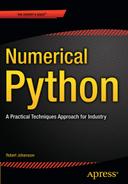Book Description
Leverage the numerical and mathematical modules in Python and its Standard Library as well as popular open source numerical Python packages like NumPy, SciPy, SymPy, Matplotlib, Pandas, and more to numerically compute solutions and mathematically model applications in a number of areas like big data, cloud computing, financial engineering, business management and more.
After reading and using Numerical Python, you will have seen examples and case studies from many areas of computing, and gained familiarity with basic computing techniques such as array-based and symbolic computing, all-around practical skills such as visualisation and numerical file I/O, general computational methods such as equation solving, optimization, interpolation and integration, and domain-specific computational problems, such as differential equation solving, data analysis, statistical modeling and machine learning.
Python has gained widespread popularity as a computing language: It is nowadays employed for computing by practitioners in such diverse fields as for example scientific research, engineering, finance, and data analytics. One reason for the popularity of Python is its high-level and easy-to-work-with syntax, which enables the rapid development and exploratory computing that is required in modern computational work.
